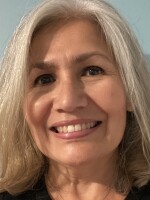Are you size 4? A 6? An 8? Often women shoppers don't know. And they can actually be all those sizes without gaining or losing an ounce.
Ed Gribbin, president of Alvanon, a clothing size and fit consulting firm in New York City, says everyone has a number in their head. When you go shopping, you instinctively look for your size, but more often than not, the item doesn't fit.
"Every brand looks at their fit as something that's proprietary, like their 'secret sauce,' and none is willing to share that info with anyone else," Gribbin says. He says that what consumers need is to be able to shop within a brand and find consistency.
And that's what Alvanon does, Gribbin says.
The company is the largest maker of mannequin body forms in the world. These mannequins are important because they are the template for clothing makers to create sizes. Alvanon works with brands to expand the number of people it can dress by focusing on not only size numbers but also body shapes. Clients include brands like Nike, Target, Levi's, J.C. Penney, REI, The North Face, Lacoste and Hugo Boss.

Alvanon uses a device called AlvaScan to create their mannequin forms. Developed in 2001, it's a booth of sorts where a fully clothed person steps in, and a full-body laser scanner moves up and down to capture accurate measurement data in seconds. The data is transferred to a computer and used to create a 3-D virtual body, the starting point for making a mannequin.
Alvanon has built the largest global database of body measurements, often placing the scanners in retail stores or malls.
"Every single one of our mannequins is based on thousands and thousands of body scans of real people. And when we go to our database, we have empirical evidence that backs up what real women out there who are 8 or 10 really look like." Gribbin says. "There is no perfect anything. We are so diverse that in any given size, there are probably four or six different body types that are represented."
Gribbin says every single human being is asymmetrical; everyone has one shoulder higher than another, one bicep or thigh larger than the other. Plus, he says, different ethnicities are shaped differently.
"The Asian body shape is different than a Western body shape in balance and distribution," Gribbin says. "So even if the measurements are the same, the Asian body is skeletally wider left to right but shallower front to back than a Western body with the same measurements."
Before Alvanon's AlvaScan, size was a clothing company's interpretations of measurements — not based on empirical evidence on how the body is shaped. Companies typically used live models to make and tailor their clothes, and some still do.
Gribbin says color may be the No. 1 reason shoppers gravitate toward a garment, "but fit is the No. 1 reason people buy it [or] return it, and it's the No. 1 reason they go back to a particular brand."
And that's why brands don't share information on sizing and instead guard their "secret sauce" ferociously. Even if it means their size 4 is really a 6 or a 2 somewhere else.
Copyright 2020 NPR. To see more, visit https://www.npr.org. 9(MDAxNDQ2NDAxMDEyNzU2NzM2ODA3ZGI1ZA001))







